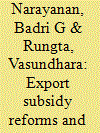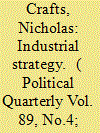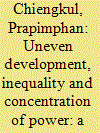| Srl | Item |
| 1 |
ID:
133886


|
|
|
|
|
| Publication |
2014.
|
| Summary/Abstract |
The World Trade Organization (WTO) recommends all members to phase out their export subsidies. While this may render export-oriented industries susceptible to tighter competition in their import markets, productivity improvements could help offset such disadvantages. This article explores the interaction between these two different aspects to evaluate the economy-wide impact of export subsidy reforms and productivity improvements in the Indian textile and clothing sector. Our analysis stands on various policy simulations applying the general equilibrium model of the Global Trade Analysis Project (GTAP; Hertel, 1997). The welfare impacts of the removal of Indian textile and clothing subsidies in terms of equivalent variation shows that India is expected to encounter a loss of about 71.5 million US$, while other Asian countries may gain about 218 million US$. In a different scenario, we simulate the impact of a complete phase-out of subsidies provided to the textile and clothing industry of India and a simultaneous increase in total factor productivity growth to 3.5 per cent. This leads to a net positive welfare change and an expected gain of about US$ 13.17 million in terms of allocative efficiency. We conclude that merely removing subsidies is not enough, as is often argued by Indian policymakers that such a policy reversal might result in contraction of the sector. Investments in total factor productivity should come about simultaneously, probably by employing surplus funds from saved subsidy payments in areas like research and development and infrastructure. This conclusion may be qualitatively generalised for any sector in the world, which is examined for export subsidy reforms, but similar economy-wide studies are recommended for specific cases.
|
|
|
|
|
|
|
|
|
|
|
|
|
|
|
|
| 2 |
ID:
162605


|
|
|
|
|
| Summary/Abstract |
The remedies provided in Prosperity and Justice: a Plan for the New Economy are less convincing than its diagnosis. It entails a substantial shift back towards selective industrial policies and resource allocation by the state rather than the market, with the ambition of changing the structure of the economy. Many economists are likely to be sceptical of some of the arguments put forward in the report. An obvious issue is the huge policy discretion to be given to government without effective constraints, and the significance of government failure is overlooked. It is a triumph of hope over experience.
|
|
|
|
|
|
|
|
|
|
|
|
|
|
|
|
| 3 |
ID:
167579


|
|
|
|
|
| Summary/Abstract |
This article provides a critique of the Thailand 4.0 strategy to push the country out of the middle-income trap through innovation-driven, inclusive and sustainable growth. First, it argues that the policies have insufficiently analysed the persistence of structural hierarchy and uneven development in the global political economy, which will constrain Thailand’s catch-up success in the future. Second, based on writings about progressive mission-led industrial strategies, it is argued that Thailand 4.0 ought to embed a progressive social and environmental agenda more clearly in its industrial strategy. Third, it is argued that Thailand 4.0 neglects to address the high concentration of political and economic power in the country, and also continues to allow unequal access to the policymaking process that has led to socio-environmental problems. Overall, this article argues that Thailand 4.0 will increasingly aggravate the two-tier fragmented nature of the political economic system of Thailand, where few can reap the biggest shares of the surplus and participate in more advanced sectors of the economy. It also calls for a more progressive industrial strategy and an alternative developmental path.
|
|
|
|
|
|
|
|
|
|
|
|
|
|
|
|